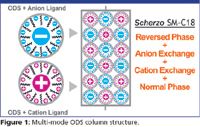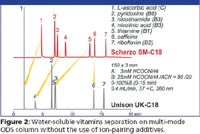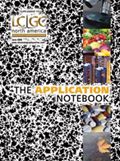A Novel Multi-Mode ODS Column Which Consists of Anion Exchange, Cation Exchange, Normal Phase, and Reversed Phase Mode
Many polar compounds are difficult to retain by reversed-phase analysis without the use of ion-pair chromatography. We have overcome this disadvantage with a revolutionary phase structure called "Multi-mode ODS." This technology uses uniformly blended packing material consisting of two types of porous silica particles: 3 μm silica substituted with ODS+cation ligands and 3 μm silica substituted with ODS+anion ligands (Figure 1). This novel multi-mode ODS column, named Scherzo SM-C18, enables a multi-separation mode, consisting of: anion exchange, cation exchange, normal phase, and reversed-phase. In this article, we will validate this multi-separation mode by separating compounds which are difficult to separate on ODS column.
Itaru Yazawa and Bryan Evans, Imtakt USA (formerly Silvertone Sciences)
Many polar compounds are difficult to retain by reversed-phase analysis without the use of ion-pair chromatography. We have overcome this disadvantage with a revolutionary phase structure called "Multi-mode ODS." This technology uses uniformly blended packing material consisting of two types of porous silica particles: 3 μm silica substituted with ODS+cation ligands and 3 μm silica substituted with ODS+anion ligands (Figure 1). This novel multi-mode ODS column, named Scherzo SM-C18, enables a multi-separation mode, consisting of: anion exchange, cation exchange, normal phase, and reversed-phase. In this article, we will validate this multi-separation mode by separating compounds which are difficult to separate on ODS column.

Figure 1
Experimental and Results
All data was generated with a semi-micro HPLC system equipped with UV or ELS detection. The experimental conditions were similar to typical reversed phase (LC–MS) conditions. Figure 2 shows water soluble vitamin analysis on the Multi-mode ODS phase (Scherzo SM-C18) and the ODS phase (Unison UK-C18). Under these conditions (no ion pairing), the water soluble vitamins showed improved retention/separation on Scherzo SM-C18. Retention mechanism for these polar compounds on Scherzo SM-C18 is as follows: acids (ascorbic acid, nicotinic acid) are retained by anion exchange mode, amines (pyridoxine, nicotineamide, thiamine) are retained by cation exchange mode, and neutral compounds (caffeine) are retained by reversed-phase mode (similar hydrophobicity for both phases results in similar retention). Riboflavin showed similar retention on both phases due to solvent strength and ionic strength gradient elution. Figure 3 shows data for neurotransmitters. Scherzo SM-C18 shows improved retention, separation, and peak shape for these highly polar (acidic and basic) compounds. Scherzo SM-C18 can also be used under normal phase mode due to the polar anionic and cationic ligands.

Figure 2
Figure 3 shows data for ascorbic acid and tocopherol. These two compounds cannot be separated under isocratic conditions with ODS column due to the large difference in polarity. Separation (under isocratic conditions) is achieved on Scherzo SM-C18 by using a combination of normal phase and reversed-phase mode (high organic composition).

Figure 3
Conclusions
The new multi-mode ODS column, Scherzo SM-C18, improves separations of polar ionic compounds, which are difficult to retain on conventional ODS columns. This phase design allows for the use of low ionic strength pH modifiers in the eluent –making separation of polar ionic compounds possible for LC–MS applications.

Figure 4

Imtakt USA (formerly Silvertone Sciences)
1511 Walnut St., Suite 310, Philadelphia, PA 19102
tel. (888)456-HPLC, (215)665-8904, fax (501)646-3497
Website: www.imtaktusa.com

Pick Your Poison. Isolation of Paclitaxel (Mar 2025)
March 7th 2025The diterpenoid, paclitaxel, which was identified as a potent chemotherapy agent for breast and ovarian cancer originates from the Pacific Yew tree. The isolation of paclitaxel from its major impurities is shown with the use of Hamilton’s PRP-1 (5 µm) HPLC column.















